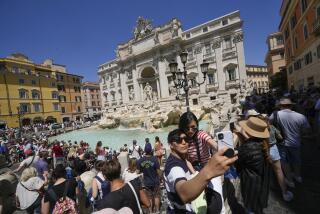Ask for Tax Refund After Shopping in Europe
- Share via
If you’re the typical American traveling to Europe this summer, chances are you’re going to spend at least some of your time shopping. But you might not realize that you may be entitled to a partial refund on what you pay for goods purchased there.
Shopping consistently ranks among the top vacation activities for U.S. travelers overseas, according to the U.S. Travel and Tourism Administration in Washington. The average American spends more than $2,500 on a European vacation--and some estimate that at least 10% of that goes to clothing, china, crystal, watches, souvenirs and other goods that tourists plan to bring home.
However, few Americans realize that “value-added taxes” account for up to 24% of the price of goods they buy in Europe. A value-added tax is essentially a sales tax that’s tacked on to the cost of goods at every stage of production. While the tax is substantial, it’s hidden because it’s simply factored into the cost of everything you buy, rather than added in at the time of purchase.
Fortunately, in some cases, the tax is refundable.
If you buy a $100 sweater in Sweden, for example, you can apply for a $20 VAT credit. The $500 designer gown bought in Paris, where VATs account for 15.7% of your purchase price, would make you eligible for a $78 refund. And the $350 crystal set you pick up in London could net you a 14.9% refund, or $52.
You also pay VATs on car rentals, hotel accommodations and meals. The refunds apply only to items that tourists take home. (Separate, and somewhat more generous, rules apply to business travelers.)
Still, roughly $30 million in VAT refunds go unclaimed each year, says Steve Jarmel, a spokesman for Europe Tax-Free Shopping, a Chicago-based service that helps U.S. tourists get VAT refunds.
Why? The taxes are complicated and easily misunderstood, and the rules about how to qualify for a refund vary. For example, though VATs are charged all through Europe, in some cases you can get a refund only if your purchase exceeds a certain amount. The amount varies from country to country, sometimes even from store to store.
In Sweden, a tourist can get a 20% VAT refund if he or she buys something worth more than about $15. (The minimums are set in each country’s currency, so fluctuations in the value of the dollar affect the VAT minimum purchase hurdle.) In France, tourists can receive VAT refunds only if they purchase merchandise worth more than 2,000 francs--that’s about $385 at today’s sorry exchange rates--in a single store.
In Britain, stores set their own minimums. Typically, British merchants won’t fill out the VAT refund paperwork unless you buy more than $50 to $75 worth of goods, says Robin Prestage, a spokesman for the British Tourist Authority in New York.
To further complicate matters, refunding the VAT is voluntary. Generally speaking, merchants do it because it’s good business. But some don’t--and they don’t have to. Even merchants who provide the refunds won’t necessarily offer them unless you ask.
“Salespeople don’t talk as much in Europe as they do here,” says one European official. “They tend not to volunteer a lot of information about the VAT or anything else.”
The bottom line: If you want a VAT refund, ask in the store if it’s available. And you must ask the clerk to fill out the paperwork before you leave.
How exactly does it work? Again, the answer varies in different countries, but consider how the system works in England, one of the top destinations among U.S. tourists.
Merchants decide whether to provide VAT refunds, then set their own minimums. Once you exceed the threshold, however, the refund amount is calculated on the entire purchase price, not merely on the amount that exceeds the threshold. In other words, a $100 item would net a $14.90 refund in a London store regardless of whether the store’s minimum is $50 or $75 or $100.
To get the refund, ask the sales clerk to fill out a VAT refund form for you. Then hold on to your sales receipt and the paperwork until you leave the country.
At the airport, a customs agent must sign the VAT form, verifying that you are, indeed, exporting the purchased items out of Europe. (If you’re having the item shipped home, the store should subtract the VAT from the cost at the time of sale, because the store is exporting the item. But again, ask to be sure.)
Once customs has stamped your VAT form, you have two choices: You can apply for a refund directly through the government--there are often government VAT refund desks in the airport--or you can take the paperwork to a refund service, such as Europe Tax-Free Shopping, also frequently found in airports.
Refund services should give you the refund immediately, either in cash or by crediting your charge card. But they’ll charge a hefty fee to do it. Europe Tax-Free Shopping, for example, charges 20% of the refund amount.
The government will give you the full amount, but it may take months. Checks are denominated in the foreign country’s currency, so you could have to pay a bank fee to convert the money to U.S. dollars. But if you ask, you can often have foreign government refunds credited to your charge card. The credit card company automatically converts the refund to U.S. dollars.
More to Read
Sign up for The Wild
We’ll help you find the best places to hike, bike and run, as well as the perfect silent spots for meditation and yoga.
You may occasionally receive promotional content from the Los Angeles Times.






